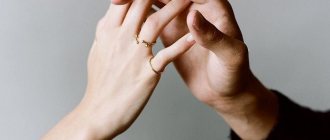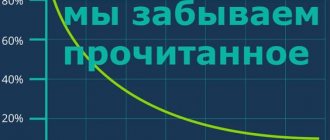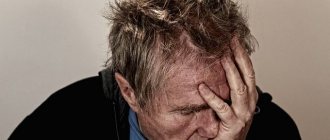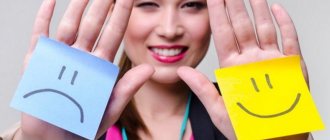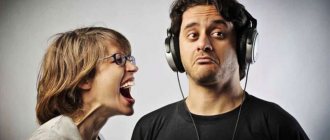Due to the fact that the centers of pleasure and stress are being actively studied at this time, the term “anhedonia” is increasingly being used. According to psychiatrists, anhedonia is the inability to experience pleasure, pleasure from the joys of life.
- Symptoms of anhedonia
- Depression and anhedonia
- The connection between anhedonia and schizophrenia
- Establishing diagnosis
- Treatment of anhedonia
- Differences and similarities between the terms “emotional inexpressiveness” and “anhedonia”
- Prevention
- Sexual anhedonia
The term arose in the middle of the last century as one of the most important symptoms of schizophrenia. A variety of sources describe the main characteristics of anhedonia differently. It represents a decrease in the ability to feel satisfaction or pleasant feelings, a decrease in interest in social life, and an almost complete absence of positive emotions while engaging in activities that were previously interesting. A person is not happy with his hobbies, the patient’s life loses color.
Evidence has been obtained that most of the identified cases of the disease are associated with a poor state of memory regarding pleasant sensations. If a healthy person takes part in an interesting event, most often he receives positive emotions that will be remembered for a long time. A patient with anhedonia practically cannot remember his sensations, therefore, his memories are either neutral or much less pleasant than those of a healthy person.
Symptoms of anhedonia
This disease can affect a variety of areas of life, which is described in detail in the specialized literature. The various areas of life into which anhedonia can penetrate are indicated. Symptoms are grouped into two broad groups: personal and social. The first group, which leads to a person being unable to enjoy previously favorite activities, includes:
- The person is withdrawn and feels uncomfortable in a new place.
- Music, books, paintings do not bring pleasant emotions to the patient - he does not understand art and, therefore, the person cannot receive pleasure from it.
- Avoidance of mass events - discos, celebrations, receptions.
- A person does not understand the reasons for the joy of loved ones.
- There is no feeling of joy, satisfaction with existence. Days can be neither happy nor darkened by failures - all are bad and colorless.
- Such people reject the usual pleasures of contact with a pet, a picnic in nature, a cultural event, delicious food, beautiful clothes, etc.
Social signs of anhedonia cause difficulties in contacts with colleagues and friends. The main ones are:
- A person cannot stay in the company of other people for a long time - he develops anxiety, begins to worry, and wants to leave as soon as possible.
- Difficulties when conducting telephone conversations - it is too painful to express your thoughts, talk for a long time.
- In a company, a person with anhedonia is not able to rejoice with those around him or to engage in something with passion, and such behavior causes bewilderment.
- In many cases, libido disappears.
A person with anhedonia is very unhappy, moreover, he is aware of his inferiority, since his life does not have what makes it happy and cheerful.
How to relearn how to enjoy life
Even realizing the presence of anhedonia, not every person has the opportunity or desire to seek professional help from a specialist. In this case, you can try to improve your condition on your own, and to do this you should take the following 3 steps.
Step 1. Decide to help yourself
This is the most important, and for many, the most difficult point of the program. Firstly, any action begins with a decision. Secondly, in cases of so-called self-psychotherapy, it can be difficult for a person to first admit that he has a problem, and then to believe that he is able to help himself.
Step 2. Find a source of pleasure
If the old sources of pleasure no longer work, then it is necessary to find new ones. What is important is that “search work” should extend to all spheres of life. It is necessary to include smell, vision, touch, taste, hearing, and body movements. Moreover, each of these groups must be studied very carefully, for example, within 2 days.
Take the sense of smell, for example. The coming Monday and Tuesday can be devoted to studying smells. These could be aromas in a perfume store, the smell of plants, fruits, herbs, vegetables, spices, essential oils. You should study aromas slowly, writing down those that you like at least a little.
Wednesday and Thursday can be spent studying the sense of touch. The goal of this exercise is to find surfaces that bring tactile pleasure. This exercise is best done with your eyes closed. Over the course of two days, a person will have to deliberately touch a variety of objects. These can be stones, leather, fur, paper, bulk and creamy substances, glass, cotton wool. Among them there will definitely be something that seems pleasant to the touch.
The next two days can be devoted to studying your taste sensations. It is better to start “research” with simple products, for example, familiar fruits, vegetables, chocolate or baked goods. Then gradually add new spices and unusual combinations of products. During the exercise, you should carefully concentrate on your own feelings, determine what you ate tasted the most pleasant.
The seventh and eighth days are the time to study sounds. It’s best to start with the sounds of nature. For example, listen to the sound of rain, wind, sounds of water, voices of different birds and animals. Then you can move on to music. But don’t force yourself to listen to the tunes you liked before. The purpose of the exercise is to find new sounds that would be pleasant to the ear.
Best materials of the month
- Coronaviruses: SARS-CoV-2 (COVID-19)
- Antibiotics for the prevention and treatment of COVID-19: how effective are they?
- The most common "office" diseases
- Does vodka kill coronavirus?
- How to stay alive on our roads?
After this exercise, you can turn your attention to visual images. You can consider anything: from color combinations to a variety of items. Among this multitude, there is sure to be at least something that will sincerely interest you. But it is important to consider objects thoughtfully, slowly, listening to your feelings.
Well, it is useful to devote the last two days of this stage of self-therapy to the search for kinesthetic pleasures, that is, the pleasures of movement. During this period, you can try everything: from dancing, swimming and yoga to martial arts. The main thing is to find those movements that you enjoy doing.
Of course, this does not mean that the practice should end after these 12 days. The listed exercises can be repeated exactly as long as a person needs to find new sources of pleasure for himself. But here you need to be extremely careful so that the source of joy does not become a source of new problems (with health, law, etc.).
Depression and anhedonia
All this explains why anhedonia is either one of the primary signs of depression, or a very common cause of it. This is confirmed by the inclusion of the disease in the worldwide classification of diseases as an indispensable depressive symptom. Both the sick person and his loved ones recognize the loss of desire for favorite activities and hobbies, become more and more unsociable, and the range of interests and communication is limited. If we are talking about depression in a child, then its sign is the refusal of favorite toys, entertainment, books, and friends.
Alogia
Many patients with schizophrenia are laconic; they are characterized by low speech productivity, slowness in answering questions, and monosyllabic statements.
Alogy:
- Monosyllabic statements.
- Poverty of speech content.
- Delay in answering a question (“answering after a long pause”).
Traditionally, alogia is described in the structure of negative symptoms of schizophrenia. In our opinion, this rather complex psychopathological phenomenon is partly a consequence of the neurocognitive deficit characteristic of schizophrenia.
Return to Contents
The connection between anhedonia and schizophrenia
Many experts believe, and note this in their works, that anhedonia is one of the main signs of schizophrenia, which can be noticed already at the beginning of mental disorder. Research data ranges from 60-75% of the incidence of anhedonia in patients with this diagnosis. Over 25% suffer from a very severe form of the symptom.
The signs of anhedonia in the case of schizophrenia differ in a number of ways from how the disease can manifest itself in a depressive state. First of all, this is the so-called “flattening of the emotional sphere”, the physical inability to feel and convey feelings: very weak and completely inexpressive gestures, facial expressions, practically no reaction to the words of another person, poor intonation of speech. Anhedonia is often observed in relatives of patients with schizophrenia and serves as evidence that this is a genetic disease.
This symptom can manifest itself in the fact that all emotional reactions are significantly weakened: both pleasant and those of a negative modality, which is an important marker of how pronounced negative symptoms are, what is the degree of maladjustment in society with established schizophrenia. If paranoia and anhedonia are combined and negative sensory reactions with pronounced productive symptoms disappear, this becomes a sign of a very unfavorable course of schizophrenia.
Autism
The concept of “autism,” according to many psychiatrists, despite repeated attempts to define the “autistic spectrum of symptoms,” remains quite vague.
It appears that autism is a complex syndrome, possibly integrating a number of manifestations of schizophrenia, including cognitive and emotional impairments, as well as behavioral changes.
According to E. Bleuler (1911), autistic thinking is divorced from reality, judgments are formed in accordance not with logic and real facts, but with the affective needs of the patient.
According to G. Benedetti (1983), autism and the primary symptoms of splitting are two sides of the same disease process. In this case, autism is interpreted by the author as a protective-compensatory reaction to splitting.
Many researchers have emphasized that autism to some extent excludes empathy.
Patients become less accessible to natural external stimuli. The surrounding world, physical reality, attracts them to a much lesser extent than their own inner world, which, according to patients, is more interesting and deep.
Autism intensifies with delirium and oneiric clouding of consciousness.
Patients strive for isolation, become withdrawn, silent, have formal contact with others, showing an indifferent attitude even towards close people. “They... go into the quiet, undisturbed world of their ghosts” (Schüle G., 1988).
Passivity is a fairly common companion to autism. The patient may not leave the house for a long time and lie in bed for a long time. Here there is a violation of social communications, a narrowing of the circle of communication and, most importantly, the need for it.
Differential diagnosis of autism symptoms in schizotypal, schizoaffective disorders and paranoid schizophrenia is presented in Table 13.
Autism syndrome includes signs of altered thinking: increased passive imagination and impaired logical reasoning. It is difficult for a patient with schizophrenia with distinct symptoms of autism to put himself in the shoes of another person, to recognize his feelings, to understand what the latter means, what meaning he puts into his words and what his intentions are.
Studies have shown that a person with schizophrenia, no matter how developed his intelligence, has difficulty understanding incorrect statements and deception.
In autism, certain intersections can be traced with the difficulty of understanding oneself, insufficient autobiographical memory, and impaired reasoning ability.
Table 13. Differential diagnosis of autism symptoms in schizotypal, schizoaffective disorders and paranoid schizophrenia
| Schizophrenia spectrum disorders | Schizotypal disorders | Schizoaffective disorders | Schizophrenia |
| Behavior | Changes in external behavior, its stereotyping | Passive submission | Ambivalent behavior |
| Social communications | Changes in social communications, isolation, unsociability, loss of interest in public life | Narrowing the circle of interests | Social isolation, isolation |
| Thinking | Violation of the adequacy of the goals set, due to switching to the world of the desired imaginary reality | Decline in creativity | Reasoning, amorphous thinking. Various forms of autistic thinking: overvalued and delusional variants, delusional fantasizing |
| Personality Features | Introversion, decreased mental flexibility and personality plasticity, rigidity | Leveling individual properties of temperament | Apathy, abulia |
| Attitude to illness | Total anosognosia | Nosognosia (shift of the disease into the past, psychologization and somatization, recognition of individual signs of the disease | Partial anosognosia |
Supporters of Z. Freud interpreted autism and decreased activity as an unsuccessful attempt at pathological compensation, “a separation from the orientation to reality.” Thus, the biological genesis of a number of manifestations of schizophrenia was denied.
According to the information theory, especially popular in the 60-70s of the twentieth century, blocking information when the brain is unable to adequately process it contributes to the emergence of autism in schizophrenia (Nuller Yu.L., 2000).
In childhood, the first descriptions of autism belong to H. Asperger (“Autistic psychopathy in childhood,” 1944) and L. Kanner (“Nervous Child,” 1943). Interest in childhood autism increased significantly after the work of L. Wing (1981). The incidence of autism is 10 per 10,000 population, Asperger's syndrome - 2 per 10,000 population. Boys get sick more often than girls, in an approximate ratio, according to ICD-10 8:1. Differential diagnosis of autism and Asperger's syndrome due to some social neglect, communication impairment, limited interests, stereotypical behavior is usually carried out with such mental disorders as obsessive-compulsive, schizoid/schizotypal personality changes, social phobia and schizophrenia.
Establishing diagnosis
There are no tests specifically designed to measure anhedonia. The presence of the disease is revealed by interviewing the person. The specialist is interested in the patient’s pastime: whether he takes part in various types of social activities, whether he attends the theater, exhibitions, cinema, concerts, how often this happens and how it affects the person’s emotional state. You can ask questions directly: does a person enjoy doing handicrafts, gardening or other hobbies, or crowded events? If a person has no friends, is socially inactive, does not attend crowded places and mass events, this can be considered a basis for making a diagnosis.
Historical aspect
Interest in the nature of pleasure and its absence goes back to ancient Greek philosophers such as Epicurus, the founder of the philosophical doctrine according to which the absence of pain, fear, anxiety, as well as the receipt of pleasure and enjoyment is the highest good and purpose of life. The symptoms of anhedonia were introduced into the field of psychopathology in 1809 by John Haslam, who described a patient suffering from schizophrenia as indifferent to “those objects and activities which were formerly sources of delight and pleasure.” But Theodule Ribot, a French psychologist and teacher, formulated it into a concept. It was later used by psychiatrists Eugen Bleuler and Emil Kraepelin to describe the core symptom of schizophrenia. Later, Lauren and Jean Chapman began to distinguish between two types of anhedonia: physical anhedonia, or a deficit in the ability to experience physical pleasure, and social anhedonia, an inability to experience interpersonal pleasure.
Treatment of anhedonia
It is almost impossible to cure anhedonia on your own. Since very often it is only a symptom of another disease, it is necessary to treat, first of all, the cause, and anhedonia itself will go away as the underlying disease gets rid of. However, there is a set of therapeutic techniques related to the treatment of anhedonia itself.
- Establishing a well-organized daily routine - 8 hours of sleep at night, proper nutrition, dosed physical activity.
- Eating foods rich in serotonin: fresh fruits, chocolate.
- Focusing on positive events, creating favorable and joyful situations.
- Correction by a psychotherapist: the use of behavioral techniques, Gestalt therapy, psychoanalysis.
- Drug treatment: treatment with antidepressants determined by the doctor.
Definition
The term “anhedonia” was first introduced by Théodule Ribot in 1896, and he defined it as a limited ability to experience pleasure. “There are many types of pathological depression. Sometimes it is the usual passive joylessness and hopelessness, depression, lack of taste for anything, enthusiasm, energy. "Professor Ribot proposed the name 'anhedonia' to describe this condition." Previously, this term was used to refer to “affective dulling” (“affective flattening”), that is, to describe the weak expressiveness of emotions, gestures and facial expressions in a person. Which was especially often used in the context of post-traumatic stress disorder. Also, early definitions of anhedonia focused on the person's lack of feelings of satisfaction. Current conceptualizations emphasize the need to examine other aspects of enjoyable activities, such as motivation or desire to engage in a particular activity (motivational anhedonia) as opposed to the level of enjoyment of the activity itself.
Differences and similarities between the terms “emotional inexpressiveness” and “anhedonia”
Anhedonia is a disease in which the patient is unable to feel satisfaction from things that previously gave him pleasure. It can be identified in a number of cases of mental pathologies and is defined as one of the most important signs of depressive syndrome.
emotional inexpressiveness to be a side effect of SSRIs. Its manifestations are a weakening of sensory reactions to all life situations, both joyful and sad.
The periodic confusion in the definition of these concepts is explained by the fact that emotional inexpressiveness manifests itself in different ways, including that positive feelings can be expressed very weakly.
Taking into account the qualitative research data published in the article “Emotional side effects of selective serotonin reuptake inhibitors: qualitative study” (BJP, 2009; 195 (3): 211-217), patients who took selective serotonin reuptake inhibitors:
- They indicated increased emotional inexpressiveness. They experienced a decrease in the severity of all feelings they experienced.
- Felt emotions more like thoughts;
- We talked about some side effects:
- low degree of frequency and strength of positive feelings: joy, happiness, desire to work, affection, enthusiasm, etc.;
- negative feelings are also weakly expressed: sadness, anger, irritation, anxiety, inability to cry out;
- some detachment;
- the desire to take care of oneself and people and animals disappears;
- personality changes.
Such emotional inertia affects the private life of sick people, as a result of which they could independently identify these symptoms. All of the above gives the right to assert that the concepts of “anhedonia” and “emotional inexpressiveness” are not synonymous, although they significantly affect the patient, preventing him from realizing himself in the personal and public spheres and fully recovering emotionally and socially.
Publications in the media
Mood disorders are disorders in which the main disturbance is a change in affect or mood towards elevation (mania) or depression (depression), accompanied by a change in the general level of activity. Depressive and manic states can occur in many somatic and almost all mental illnesses, and can also be caused by drugs (for example, narcotic analgesics, antihypertensives, antitumor drugs, sedatives, antiparkinsonian drugs, antibiotics, antipsychotics, GCs).
Frequency. The lifetime risk of developing various forms of mood disorders is 8–9%. Women get sick 2 times more often with a predominance of depressive variants. Only 20% of patients go to medical institutions, half of them do not realize the nature of their disease and present somatic complaints, and only 30% are recognized by a doctor. 25% of patients receive adequate therapy. CLINICAL PICTURE The clinical picture of mood disorders includes depressive and manic syndromes. Depressive syndromes Depending on the number and severity of symptoms, depressive syndromes are classified as mild, moderate and severe. • Moderately severe depressive syndrome •• Decreased mood with a feeling of melancholy, slower pace of thinking and motor retardation are the main signs of depressive syndrome •• The appearance of patients is characteristic: a sad expression on the face, a suffering vertical fold between the eyebrows, hunched posture, head down, gaze fixed down. Despite their difficult mental state, some patients are able to joke and smile (“smiling depression”) •• Motor retardation is a common symptom of depression (although agitation, described below for agitated depression, is not excluded). The patient's movements are slow and performed only when absolutely necessary. With severe motor retardation, patients spend most of their time lying in bed or sitting, without feeling the need for active action. The slowing down of the pace of thinking is reflected in the speech of patients: questions are answered with a long delay, after long pauses •• Patients are especially painfully experiencing a depressed mood with a feeling of melancholy. Patients rarely describe their condition as low mood. More often they complain of sadness, a feeling of melancholy, lethargy, apathy, depression, depression. Melancholy is described by patients as mental heaviness in the chest, in the area of the heart, in the head, sometimes in the neck or abdomen; explain that this mental, “moral” pain •• Other common symptoms of depression are anxiety (see Anxiety disorders) and irritability. The increase in anxiety most often occurs in the evening. As depression deepens, anxiety turns into agitation: patients in this state are unable to sit still, rush about, moan, and wring their hands; often attempt suicide in the presence of medical personnel or other persons. Irritability in depression is manifested by constant irritation, gloominess, dissatisfaction with oneself and others •• Loss of interests and the ability to have fun. Patients complain about their insensitivity, say that the feelings of other people are inaccessible to them, everything around them loses value (here this condition should not be confused with emotional emptiness in patients with schizophrenia). In severe cases, patients claim that they have lost love for people previously dear to them, have ceased to feel the beauty of nature, music, and have generally become insensitive; talking about this, patients have a hard time experiencing their change, so this condition is called painful mental insensitivity (anaesthesia psychica dolorosa) •• Almost all patients with depression complain of decreased energy, it is difficult for them to start something, to finish what they started; academic performance and productivity decreases. Many patients attribute their lack of energy to some physical illness. •• With depressive syndrome, biological symptoms are often observed. These include sleep disorders (early awakenings are the most typical: the patient wakes up 2-3 hours before the usual time of awakening and can no longer fall asleep, experiences anxiety, restlessness, thinks about the coming day), diurnal mood swings (deterioration of mood in the morning), decreased appetite, weight loss, constipation, amenorrhea, decreased sexual function •• Depressive thoughts (depressive thinking) are an important symptom of depression. Identifying depressive thoughts helps the doctor predict and prevent possible suicide attempts. Depressive thoughts can be divided into three groups ••• The first group relates to the present time. Patients perceive their surroundings in a gloomy light and are focused on thoughts of self-deprecation. For example, the patient believes that he cannot cope with his work, and those around him consider him a failure, despite obvious successes ••• The second group concerns the future tense. Patients completely lose hope for anything good in the future, are filled with a feeling of hopelessness, the hopelessness of their situation and the aimlessness of further life. For example, the patient is sure that in the future he will become unemployed or get cancer). Suicidal attempts during depression are most often caused by this particular group of depressive thoughts ••• The third group refers to the past tense. Patients experience an inappropriately strong feeling of guilt, remembering minor misdeeds from a past life, cases when they behaved insufficiently ethically, made mistakes, etc. •• Complaints about somatic symptoms are often noted in depression. They can be very diverse, but the most common complaints are constipation and pain (or discomfort) in any part of the body •• With depressive syndrome, other mental disorders are observed: depersonalization, obsessive states (see Obsessive-compulsive disorder), phobias (see Disorders phobic), etc. •• Patients often complain of memory impairment, which is associated with impaired concentration. However, if the patient makes an effort, then the processes of memorization and reproduction themselves turn out to be intact. But sometimes these memory impairments, especially in the elderly, become so severe that the clinical picture is similar to dementia. • Masked depression •• Masked (larved, hidden) depression is a subdepressive state combined with somatic disorders dominant in the clinical picture that mask low mood. The frequency of masked depression exceeds the number of overt depression by 10–20 times. Initially, such patients are treated by doctors of various specialties, most often by therapists and neurologists. Masked depression is most often observed in mild and moderate depressive syndrome, and much less frequently in severe depressive syndrome. •• The most common complaints are complaints about disorders of the cardiovascular system (attacks of pain in the heart) and digestive organs (decreased appetite, diarrhea, constipation, flatulence, abdominal pain). Various sleep disorders are very often noted. Patients complain of a feeling of loss of strength, weakness, loss of interest in favorite activities, a feeling of vague anxiety, rapidly developing fatigue when reading a book or watching television •• There are often cases when masked depression causes alcohol abuse.
• Severe depressive syndrome •• With further development and severity of the depressive syndrome, all of its symptoms described above appear with greater intensity. A distinctive feature of severe depressive syndrome is the addition of psychotic symptoms: delusions and hallucinations (therefore, some authors call this disorder the term “psychotic depression”) •• Delusions in severe depressive syndrome are represented by ideas of self-abasement, guilt, the presence of severe somatic diseases (hypochondriacal delusions) •• With severe depressive syndrome, patients most often experience auditory hallucinations, the content of which reflects the painful depressive state of the patients. For example, a patient hears a voice reporting the hopelessness and meaninglessness of his suffering, recommendations to commit suicide, or the groans of dying loved ones, their calls for help, etc. Much less often, patients experience visual hallucinations, which also reflect a depressive mood (for example, scenes of death or execution). • Agitated depression - depression with agitation. Agitation is motor restlessness combined with anxiety and fear. Patients are extremely tense and do not find a place for themselves: they stereotypically rub their hands, finger their clothes with their hands, walk a lot, persistently turn to the staff and others with some kind of request or remark, sometimes they stand at the doors of the department for hours, shifting from foot to foot and grabbing clothes passing.
• Inhibited (adynamic) depression. With inhibited depression, the leading symptom is psychomotor retardation. In some cases, the severity of psychomotor retardation reaches the level of stupor (depressive stupor). If symptoms reverse during treatment, when depression is still strong and motor retardation disappears, the risk of suicide increases sharply! • Mild depressive syndrome (subdepression) - depression of mild severity. The affect of deep melancholy and motor retardation are absent, outwardly the behavior of patients can remain orderly, although devoid of energy and activity. The patients' condition is dominated by anhedonia, lack of mood, anxiety, and self-doubt. Patients note that in the morning it is difficult to force themselves to get out of bed, get dressed, and wash; Carrying out the usual duties at home and at work requires a lot of effort, there are no desires, there is no confidence in the success of any undertaking. When waking up, there is no sensation of transition from sleep to wakefulness - hence the unfounded complaints of “complete insomnia.” Anxiety, common in subdepression, is often accompanied by hypochondria, obsessive thoughts and phobias.
Manic syndrome Manic syndrome is a combination of elevated mood, accelerated tempo of thinking and increased motor activity. • Patients' appearance often reflects elevated mood. Patients, especially women, tend to dress brightly and provocatively, and use cosmetics excessively. The eyes are shiny, the face is hyperemic, and when talking, splashes of saliva often fly out of the mouth. Facial expressions are lively, movements are fast and impetuous, gestures and postures are emphatically expressive. • High spirits are combined with unshakable optimism. All the experiences of patients are painted only in rainbow tones. Patients are carefree and have no problems. Past troubles and misfortunes are forgotten, the future is painted only in bright colors. Patients describe their own physical well-being as excellent; the feeling of excess energy is a constant phenomenon. At first glance, such patients may give an outside observer the impression of being mentally healthy, but unusually cheerful, cheerful and sociable. Other patients experience irritability and easily develop reactions of anger and hostility. Orientation, as a rule, is not impaired, but consciousness of the disease is often absent. • Increased motor activity - patients are constantly on the move, cannot sit still, walk, interfere in everything, try to command the patients, etc. During conversations with a doctor, patients often change their position, spin, jump up, begin to walk and often even run around the office. They take on any task, but only move from one thing to another, without bringing anything to the end. Patients with manic syndrome are very willing to communicate with others and actively intervene in conversations that do not concern them in any way. • Acceleration of the pace of thinking - patients talk a lot, loudly, quickly, often without stopping. With prolonged speech stimulation, the voice becomes hoarse. The content of the statements is inconsistent. Easily move from one topic to another. With increasing speech excitement, a thought that does not have time to finish is already replaced by another, as a result of which statements become fragmentary (“jump of ideas”). The speech alternates with jokes, witticisms, puns, foreign words, and quotes.
• Sleep disturbances manifest themselves in the fact that patients sleep little (3–5 hours a day), but at the same time they always feel cheerful and full of energy. • With manic syndrome, an increase in appetite and increased sexual desire are almost always noted. • Expansive ideas. The possibilities for realizing numerous plans and desires seem limitless to patients; patients do not see any obstacles to their implementation. Self-esteem is always overly elevated. It is easy to overestimate your capabilities - professional, physical, related to entrepreneurship, etc. For some time, patients can be dissuaded from exaggerating their self-esteem. Expansive ideas easily turn into expansive delusions, which are most often manifested by delusional ideas of greatness, invention and reform. • In severe manic syndrome, hallucinations are noted (rarely). Auditory hallucinations are usually of praising content (for example, voices telling the patient that he is a great inventor). With visual hallucinations, the patient sees religious scenes. • The hypomanic state (hypomania) is characterized by the same features as severe mania, but all symptoms are smoothed out, there are no gross behavioral disorders leading to complete social maladjustment. Patients are active, energetic, prone to jokes, and overly talkative. The increase in their mood does not reach the level of conspicuous indomitable gaiety, but is manifested by cheerfulness and optimistic faith in the success of any undertaking. Many plans and ideas arise, sometimes useful and reasonable, sometimes overly risky and frivolous. They make dubious acquaintances, lead an indiscriminate sex life, begin to abuse alcohol, and easily take the path of breaking the law.
CLASSIFICATION OF MOOD DISORDERS Classifications based on etiology • Endogenous and reactive depression. The terms “endogenous” and “reactive” are not included in the modern classification of mental illnesses, but some psychiatrists still use these concepts. With endogenous depression, symptoms are caused by factors not related to the patient’s personality and do not depend on the traumatic situation. In reactive depression, symptoms are directly related to traumatic situations. In practice, only endogenous or only reactive depressions are rare; Mixed depression is much more common. • Primary and secondary depressive syndromes. Secondary depressive syndromes are caused by another mental disorder (for example, schizophrenia, neurosis, alcoholism), a somatic or neurological disease, or the use of certain drugs (for example, GCs). In the case of primary depressive syndrome, it is not possible to detect any cause that caused the depression.
Classification based on symptoms • Neurotic and psychotic depression. With neurotic depression, the symptoms characteristic of psychotic depression (severe depressive syndrome) are more smoothed out, less pronounced, and are often caused by traumatic situations. Neurotic depression is often accompanied by neurotic symptoms such as anxiety, phobias, obsessive-compulsive disorder and, less commonly, dissociative symptoms. In the modern ICD-10 classification, neurotic depression is described as “dysthymia”.
Classification based on course • Bipolar mood disorder •• In the previous ICD-10 classification, these disorders were described under the term “manic-depressive psychosis.” Bipolar mood disorder manifests itself in alternating manic or depressive phases (episodes). Episodes can immediately follow each other (for example, a depressive state is immediately replaced by a manic syndrome) or at intervals of complete mental health (for example, a patient has emerged from a depressive state and after a few months a manic syndrome develops). The disorder does not lead to a decrease in mental functions even with a large number of phases experienced and any duration of the disease •• Bipolar disorders usually begin with depression. To make a diagnosis of bipolar disorder, the development of at least one manic (or hypomanic) episode during the course of the disease is sufficient. • Cyclothymia (cyclothymic disorder) is characterized by a chronic course with numerous and short-lived episodes of hypomanic and subdepressive states. Cyclothymia can be thought of as a milder version of bipolar disorder. Clinical manifestations are similar to those of bipolar mood disorder, but they are either less pronounced or less persistent. The duration of the phases is significantly shorter than in bipolar disorder (2–6 days). Episodes of disturbed mood occur irregularly, often suddenly. In severe cases, there are no “bright” intervals of normal mood. The onset of the disease is usually gradual and occurs between the ages of 15 and 25 years. 5–10% of patients develop drug addiction. The history indicates frequent changes of residence and involvement in religious and occult sects. • Depressive disorders •• Recurrent depressive mood disorder (unipolar depression, unipolar mood disorder) is a disease that occurs in the form of several major depressive episodes throughout life, separated by periods of complete mental health. The first episode can occur at any age, from childhood to old age. Its onset can be acute or unnoticeable, and its duration can range from several weeks to many months. The risk of a person with recurrent depressive disorder never having a manic episode is never completely eliminated. If this happens, the diagnosis is changed to bipolar affective disorder. Depressive disorders do not lead to a decrease in mental functions even with a large number of phases experienced and any duration of the disease •• Seasonal affective disorder - depression that occurs in winter, with a reduction in daylight hours. Decreases and disappears with the onset of spring and summer. Characterized by drowsiness, increased appetite and psychomotor retardation. Associated with pathological metabolism of melatonin •• Currently, neurotic depression and erased forms of recurrent depressive disorder are combined into dysthymic disorder. In the ICD-10 classification, neurotic depression (depressive neurosis) is included in dysthymic disorder (dysthymia). Dysthymia is a less severe form of depression, usually caused by a long-term traumatic situation. The disorder tends to be chronic. With dysthymia, the symptoms characteristic of severe depressive syndrome are more smoothed out and less pronounced.
DIFFERENTIAL DIAGNOSTICS OF MOOD DISORDERS • Grief reaction. Depressive disorders must be distinguished from the normal grief reaction to severe emotional stress (for example, the death of a child). The grief reaction differs from depressive disorder in the absence of thoughts of committing suicide; patients are easily persuaded, and their condition is alleviated when communicating with other people. Treating grief-stricken patients with antidepressants is ineffective. Some patients with grief reactions subsequently develop major depressive disorder. • Anxiety disorder can be difficult to distinguish from subdepressive conditions, especially since anxiety and depression often co-occur. To make a correct diagnosis, it is necessary to assess the severity of anxiety and depression, as well as the sequence of their onset. If the patient’s symptoms of depression are more pronounced and appear first, and then anxiety joins in, then a diagnosis of depressive disorder is more likely. Conversely, if the disease begins with symptoms of anxiety, which are the only manifestations of the clinical picture, and then symptoms of depression appear, then the patient most likely has an anxiety disorder. The same principle is used in the differential diagnosis of obsessive-compulsive and phobic disorders. • Schizophrenia. Delusions and hallucinations are observed in both manic and depressive episodes. Mood disorders do not lead to a decrease in mental functions even with a large number of phases experienced and any duration of the disease. Whereas in schizophrenia, negative symptoms are observed, leading to persistent personality changes. • Schizoaffective disorder. In cases where the clinical picture shows equally pronounced symptoms of a mood disorder (manic or depressive syndrome) and schizophrenia, a diagnosis of schizoaffective disorder is more likely (see Schizoaffective disorder). • Dementia. Memory impairments in depression have a more acute onset and are caused by impaired concentration; The clinical picture also includes other symptoms of depression, such as depressive thinking. Patients with depression who complain of memory impairment usually do not hesitate to answer questions (“I don’t know”), while patients with dementia try to avoid a direct answer. In depressed patients, memory for current and past events is equally impaired; Dementia patients suffer more from memory for current events than for past ones. • Organic brain damage. When a manic state appears in old age in combination with severe behavioral disturbances (for example, public urination) and especially the absence of a history of manic and depressive episodes, one should think first of all about organic damage to the brain (most often the frontal lobe - “frontal lobe syndrome”), for example a tumor. In this case, additional studies are carried out - MRI/CT, EEG. • Mood disorders caused by substance abuse (eg, heroin, amphetamine). Substance abuse and dependence are typically accompanied by mood disorders. In differential diagnosis, anamnesis data and the results of urine tests for the content of psychoactive substances are taken into account. • Mood disorders caused by drug use. When assessing the patient’s condition, it is necessary to find out what medications he is currently taking, which ones in the past, and whether he has previously had changes in mental well-being while taking any drugs. It is important to adhere to the principle that every drug that the patient takes can be a factor causing a mood disorder.
Research methods • Laboratory methods •• General blood and urine tests •• Dexamethasone suppression test •• Study of thyroid function •• Determination of vitamin B12, folic acid • Special methods •• ECG •• EEG •• CT/MRI • Psychological methods •• Zung Self-Esteem Scale •• Hamilton Depression Scale •• Rorschach Test •• Thematic Apperception Test. Differential diagnosis • Neurological diseases (eg, epilepsy, hydrocephalus, migraine, multiple sclerosis, narcolepsy, brain tumors) • Endocrine disorders (eg, adrenogenital syndrome, hyperaldosteronism) • Psychiatric diseases (eg, dementia, schizophrenia, personality disorders, schizoaffective disorder, adjustment disorder with depressive mood). COURSE AND PROGNOSIS Depressive disorders. 15% of people with depression commit suicide. 10–15% make suicide attempts, 60% plan suicide. It should be remembered that the likelihood of suicide is greatest during the recovery period during treatment with antidepressants. A typical depressive episode, if left untreated, lasts about 10 months. At least 75% of patients experience a second episode of depression, usually within the first 6 months after the first. The average number of depressive episodes during a lifetime is 5. The prognosis is generally favorable: 50% of patients recover, 30% do not recover completely, and in 20% the disease becomes chronic. Approximately 20–30% of patients with dysthymic disorder develop (in decreasing frequency) recurrent depressive disorder (double depression), bipolar disorder. Bipolar disorders. About a third of people with cyclothymia develop bipolar mood disorder. In 45% of cases, manic episodes recur. Manic episodes, if left untreated, last 3–6 months with a high likelihood of relapse. Approximately 80–90% of patients with manic syndromes eventually develop a depressive episode. The prognosis is quite favorable: 15% of patients recover, 50–60% do not recover completely (numerous relapses with good adaptation between episodes), in a third of patients there is a possibility of the disease becoming chronic with persistent social and labor maladjustment.
TREATMENT Basic principles • Combination of drug therapy with psychotherapy • Individual selection of drugs depending on the prevailing symptoms, effectiveness and tolerability of drugs. Prescription of small doses of drugs with a gradual increase • Prescription for exacerbation of drugs that were previously effective • Revision of the treatment regimen if there is no effect within 4-6 weeks Treatment of depressive episodes • TAD - amitriptyline and imipramine. For psychomotor agitation, anxiety, restlessness, irritability or insomnia, amitriptyline is prescribed - 150–300 mg/day; for psychomotor retardation, drowsiness, apathy - imipramine 150–300 mg/day • Selective serotonin reuptake inhibitors. If depression is resistant to treatment with high doses of amitriptyline or imipramine, this does not mean that newer antidepressants will be effective in this case. The development of anticholinergic side effects is the main reason for unauthorized discontinuation of TAD treatment. In addition, amitriptyline and imipramine are contraindicated in patients with heart disease, glaucoma and prostatic hypertrophy. It is preferable for such patients to be prescribed selective serotonin reuptake inhibitors, because they are more secure. Selective serotonin reuptake inhibitors are as effective as imipramine and amitriptyline, do not cause anticholinergic side effects, and are safer in overdose. The drugs are prescribed once in the morning: fluoxetine 20–40 mg/day, sertraline 50–100 mg/day, paroxetine 10–30 mg/day. • MAO inhibitors (eg, nialamide 200–350 mg/day, preferably in 2 doses morning and afternoon) are usually less effective for severe depressive disorders than TADs, and have the same effect for mild disorders. But in some patients resistant to TAD treatment, MAO inhibitors have a therapeutic effect. The effect of drugs in this group develops slowly and reaches a maximum by 6 weeks from the start of treatment. MAO inhibitors enhance the effect of vasoconstrictor amines (including tyramine, found in some foods - cheese, cream, coffee, beer, wine, smoked meats, red wines) and synthetic amines, which can lead to severe arterial hypertension. • Electroconvulsive therapy (ECT). Clinical studies have shown that the antidepressant effect of ECT develops faster and is more effective in patients with severe depressive disorder with delusional ideas than with TAD. Thus, ECT is the method of choice in the treatment of patients suffering from depressive disorder with psychomotor retardation and delirium when drug therapy is ineffective. Synonym. Affective Disorders Abbreviations . ECT - electroconvulsive therapy
ICD-10 • F06.3 Organic mood disorders [affective] • F30 Manic episode • F31 Bipolar affective disorder • F32 Depressive episode • F33 Recurrent depressive disorder • F34 Persistent mood disorders [affective disorders] • F38 Other mood disorders [affective] • F39 Mood disorder [affective] unspecified.
Sexual anhedonia
If a person suffers from sexual anhedonia, he will experience symptoms very similar to narrowly focused apathy. Sexual intercourse is not interesting to such a person and does not lead to arousal. Indifference and coldness in relationships become a common state. During sexual intercourse, in most cases, he does not show activity, but demonstrates complete disinterest. There are two reasons for this phenomenon: repressive moral standards instilled in childhood, or the behavior of a partner that causes rejection.
Therapy
As already mentioned, anhedonia can be a consequence of neurotic or mental disorders. But it can also develop in people without such pathologies. In any case, treatment is prescribed by a specialist and is carried out under the strict supervision of a doctor.
To completely overcome the disease, patients undergo a paired complex treatment that corrects behavior, destroys stereotypes, and creates new models of action. In many cases, men underestimate and misunderstand the importance of the emotional side of sexual relations. Women should overcome their complexes, get to know their body and its needs better, accept the fact that sex is necessary and important not only for a man, but also for herself. Interest in sexual relations will not be restored immediately. Better results can be achieved in a shorter time if you treat sexual anhedonia in a medical center with highly qualified specialists and good technical equipment.
Diagnostic features
Agnedonia often manifests itself even before the appearance of clinical signs of the underlying disease. That is why diagnostic procedures (questionnaires using specially designed questionnaires, instrumental examination to exclude organic lesions of the central nervous system) are aimed at identifying possible serious mental disorders. Starting therapy in the early stages greatly increases the likelihood of a favorable outcome (complete cure or achieving long-term remission).
Sometimes, especially if the patient actively protests against visiting the clinic and has characteristic symptoms, doctors recommend testing for the presence of narcotic substances in the body. Additional examination is also needed to identify possible concomitant diseases.
In some cases, symptoms of such a disorder occur in people with certain mental characteristics, the so-called “depressive temperament.” But even in such cases, doctors at the Leto clinic select a regimen of drug treatment and psychotherapy to give the patient the opportunity to live a full life.
Kinds
1. Total or partial . The emergence of indifference to everything or only selectively in one or several life parameters.
2. Physical or social . In the first case, a person loses the opportunity to enjoy intimacy, food, active recreation, and sleep. In the second, patients avoid communicating with people, do not want to build a career, increase their income, or improve their living conditions.
3. Intellectual and aesthetic . Patients do not want to develop and learn new things; they are indifferent to literature, music, cinema, theater and even television news.
